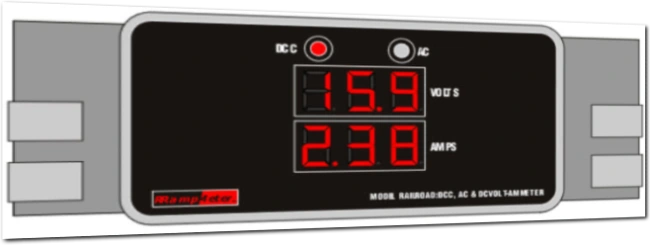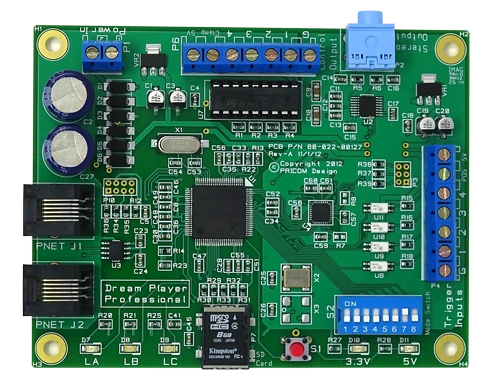Electronics
Accutrack II Cut & pasted from their website : sprog.us.com
This easy to use ACCUTRACK II Speedometer is available from our online store.
Now supporting US (1:160) and UK (1:148) N scales, H0 and 00, all in scale miles or kilometers per hour, this unit stands over any track, and displays the speed of a train as it passes, in either direction.
It is a stand-alone device, and runs off two AAA batteries, included in the package, so is ideal for DC or DCC layouts.
The speedometer uses the precision of a microcontroller to measure the time between two infrared beams that the train passes through. Based on this time, the scale speed can be calculated from a mathematically derived calibration factor.
Built into the software are the calibration factors for US (1:160) and UK (1:148) N scales, US H0 and British 00, and these factors are selectable from a button accessible from the front panel of the device.
Speed is displayed for 5 seconds and then unit goes into power saving mode.
Auto shut off after 5 minutes of no trains.

Model railway electronics will enhance your layout in many different ways. Below are some examples.
Control Systems: Electronics allows us to control points (turnouts), signals, lights, turntables, crossing gates, uncouplers making the layout dynamic and realistic.
Sound Effects: Adding sound modules lets you simulate train sounds, station announcements, and other audio effects. Imagine the sound of a steam locomotive or the whistle of a diesel engine!
Lighting: Electronics enable realistic lighting for structures, locomotives, and rolling stock. You can create illuminated buildings, traffic lights, and even simulate day and night cycles.
DCC (Digital Command Control): DCC systems use electronics to control multiple trains independently on the same track. Each locomotive has its own address, allowing precise speed and direction control.
Grade Crossing Flashers: These use electronics to mimic flashing lights and gates at level crossings when a train approaches.
Detection Circuits: Electronics help detect train presence, allowing automated actions like activating signals or triggering sound effects.
Remember, the complexity depends on how deep you want to dive into these features. Arduino comes to mind which is at the upper level of complexity and the lower level is a LED ( light emitting diode). Whether you’re a beginner or an advanced modeller, there’s something for everyone.
Control Systems: Electronics allows us to control points (turnouts), signals, lights, turntables, crossing gates, uncouplers making the layout dynamic and realistic.
Sound Effects: Adding sound modules lets you simulate train sounds, station announcements, and other audio effects. Imagine the sound of a steam locomotive or the whistle of a diesel engine!
Lighting: Electronics enable realistic lighting for structures, locomotives, and rolling stock. You can create illuminated buildings, traffic lights, and even simulate day and night cycles.
DCC (Digital Command Control): DCC systems use electronics to control multiple trains independently on the same track. Each locomotive has its own address, allowing precise speed and direction control.
Grade Crossing Flashers: These use electronics to mimic flashing lights and gates at level crossings when a train approaches.
Detection Circuits: Electronics help detect train presence, allowing automated actions like activating signals or triggering sound effects.
Remember, the complexity depends on how deep you want to dive into these features. Arduino comes to mind which is at the upper level of complexity and the lower level is a LED ( light emitting diode). Whether you’re a beginner or an advanced modeller, there’s something for everyone.

RRampmeter
The only inexpensive device that accurately measures DCC Volts/Amps.
Also measures AC and DC Volts/Amps.
Costs less than DVMs that cannot measure DCC. Ver I, II, & III rated at 10 Amps and Ver IV rated at 20 Amps.
Measures true RMS Volts/Amps, +/- 2%.
Suitable for all scales.
No batteries required.
Designed for Left/Right-hand use.
If you want more than loco sound effects, check this out
Electronics for Model Railways
Came across this document on the internet.
Each chapter (28 of them) are separate pdf's. I downloaded and combined all into one pdf.
The author has indicated the book(s) may be freely copied and distributed so here it is.
The file is large, 98 megabytes, so please take the size into consideration if you are going to download it.
This is one of the best books I have come across.
Well written with all the information you will ever need about model railway electronics.

This digital player is ideal for providing sound effects for your Model Railway.
Birds singing, dogs barking, a sawmill running, men working in the shed, maybe a logging operation?
Excellent model railway electronics source

